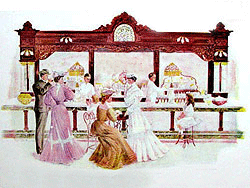


 |
 |
 |
Unless you are of a certain age, you probably have never seen a real jar for soda straws. Nowadays, straws are sensibly sanitarily enclosed in paper or cellophane until one is selected with a push of a lever. And unless you are fortunate enough to actually own one, you've probably never seen a jar for straws with a glass lid. We don't know how many straw jars with glass lids were made, but as difficult as they are to find, it wasn't many. |
 |
The origin of the soda fountain straw jar has been traced back to the year 1888. The earliest known examples were mold blown jars produced in a rainbow of colors and decorative patterns. See REVERSE SWIRL jar at left. Each jar was individually hand crafted. Few of these fragile mold blown jars were produced and far fewer have survived handling by the public and soda fountain employees. During the late 1800’s, America’s attraction turned to the brilliant sparkle of cut glass. The manufacture of cut glass, however, was labor intensive and its cost was not generally affordable for the middle class. Improvements in glass manufacture permitted EAPG to be mass produced at far less cost per unit than mold blown or cut glass. EAPG could be molded into complex patterns with improved glass formulas that created brilliance similar to expensive cut glass. Pressed pattern glass was also far more durable than earlier mold blown glass. This characteristic was particularly important to the soda fountain industry since the fragile mold blown straw jars were easily damaged during use. |
| This mold blown "Chrysanthemum Swirl Variant" jar was produced by Northwood Glass Co., c. 1888 and is an example of the earliest verifiable straw jar known. |
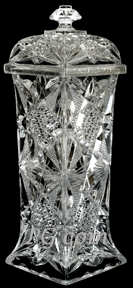 |
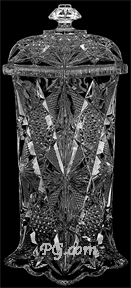 |
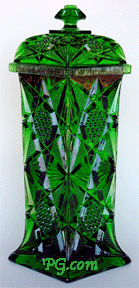 |
 |
| Above are 2 versions of the ILLINOIS Pattern by U.S. Glass Co., c. 1897. This crystal straw jar was distributed both with & without a lid. The base was sold as a vase & also served as the base for an oil lamp. On the right is a crystal ILLINOIS pattern with an unusual scalloped base believed to come from an "early generation" mold. |
A very rare Emerald green ILLINOIS Pattern jar with glass lid. This pattern was also produced with ruby stain. |
ILLINOIS Pattern oil lamp using the straw jar as a base. |
|
| As we can see, early pattern glass straw jars were heavily embossed with intricate decorative patterns. Principally made of crystal glass, two manufacturers also produced straw jars in a rare emerald green color. Other scarce examples were decorated with gold gilding and ruby or maidens blush flashing. Two Colonial pattern versions were produced in white milk glass. As the years passed, patterns became less complex and easier to clean. The Colonial pattern became the pattern of choice. |
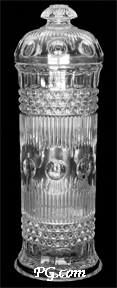 |
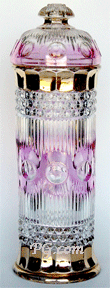 |
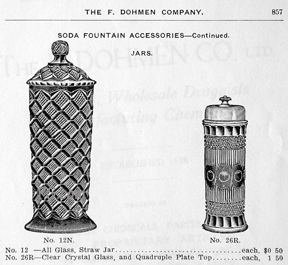 |
MANHATTAN pattern by U.S. Glass Co., |
MANHATTAN pattern decorated with Gold and Maiden's Blush flashing. |
MANHATTAN pattern with silver plate metal lid. The adjacent jar is by Cambridge Glass and is Pattern # 2500. Illustration from The Dohmen Co. Ltd., Milwaukee, Wisconsin 1907 catalog, courtesy of the American Institute of the History of Pharmacy, Kremer's Reference Files, Madison, Wisconsin. |
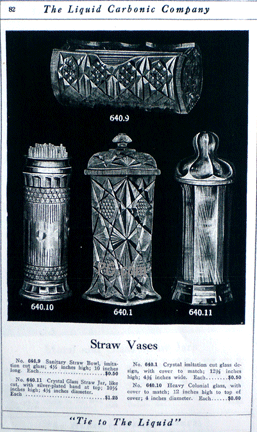 |
On the left is a picture of "The Liquid Carbonic Co." straw jar advertisement. This company was established in 1888 and became a world wide distributor of carbon dioxide equipment and compressed gas initially serving the soda fountain industry. They also sold soda fountain accessories. This advertisement comes from a 1911 catalog. Note that the straw jars are advertised as "STRAW VASES" and the Manhattan Pattern jar is shown without a lid. Instead, it has a silver plated metal ring attached to the rim. In summary, the Manhattan straw jar was distributed with a plain or decorated glass lid; two styles of silver plated metal lids; or an uncovered version with a silver plated metal band attached to the rim. |
| Illustration from The Liquid Carbonic Co., Chicago, Illinois 1911 catalog courtesy of the Chicago History Museum, Chicago, Illinois. |
| The 1911 advertisement above is interesting in that it incorrectly identifies the numbered products. Such errors were rampant in the Victorian era catalogs, which accounts for some of the errors in the early books about EAPG. In addition, wholesale catalogs would picture patterns from different companies together leading early researchers to believe that the same glass company made them all. It has taken most of a century to uncover, decipher and correct some of these errors and misunderstandings. |
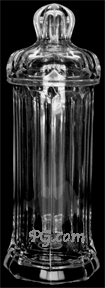 |
 |
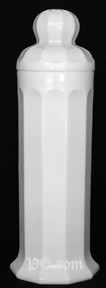 |
| On the left is a COLONIAL Pattern tall straw jar & cover by the McKee Glass Company, c. 1904 In the Center is pictured a COLONIAL Pattern #3989 by U.S. Glass Company, c. 1908. On the right is a Colonial pattern milk glass straw jar produced by the "Co-Operative Flint Glass Co." of Beaver Falls, Pa. and shown in a 1916 druggist supply catalog. These are similar to the image of the #540.11 in the advertisement shown above. |
| During the turn of the century, scientists and the public became increasingly aware that microbes were a major source of disease. Up to that time, straw jars were simply covered containers to hold the straws. A customer with dirty hands would reach in to grab a straw and end up contaminating the ends of all the surrounding straws. A close examination of the horizontal straw jars, pictured at right and below, were typically advertised as "Sanitary Straw Jars". They are shaped so that a straw can only be picked up in the middle. This was an early but flawed attempt to improve sanitation. |
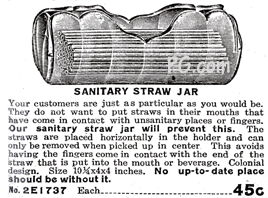 |
| The above advertisement is an Illustration from the Albert Pick & Co. 1911 catalog courtesy of the Chicago History Museum, Chicago, Illinois. |
 |
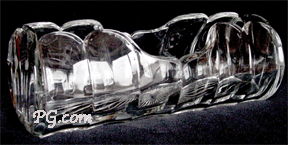 |
|
| TOLTEC Pattern horizontal sanitary straw holder by McKee Glass Co., c. 1904 | Sanitary COLONIAL Pattern horizontal straw holder by A. H. Heisey & Co., c. 1905. |
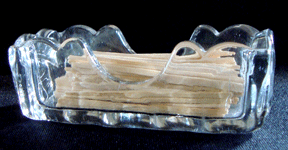 |
Interestingly, "sanitary" toothpicks were also made about this time by McKee. This one is their COLONIAL pattern |
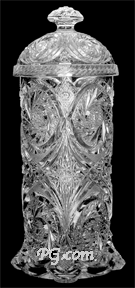 |
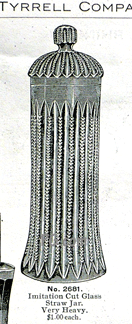 |
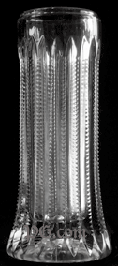 |
| AZTEC Pattern by McKee Glass Co., c. 1904. | Above is a catalog illustration of the Fostoria straw jar in the EDGEWOOD pattern. A photo of this jar is shown, on the right, minus its lid. The correct lid is either a matching glass lid as shown or a quadruple silver plated metal cover which was produced by the Benedict Mfg. Co. Illustration from the Burley & Tyrrell Co. 1907 catalog courtesy of the Chicago History Museum, Chicago, Illinois. |
EDGEWOOD Pattern straw jar by Fostoria Glass Co., c. 1898, missing its glass lid. |
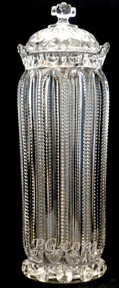 |
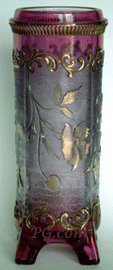 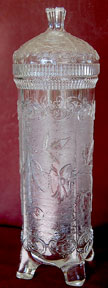 |
|
| THE PRIZE Pattern by National Glass Co. at the McKee Bros. factory, c.1900. A rare version of this jar was decorated with gold gilding & ruby stain. | BOHEMIAN aka FLORA DORA pattern by U.S. Glass Co., c. 1899. Shown in this pattern in Blush with Gold decor missing its matching lid. Also a photo, contributed by Sharon Blanks, shows the pattern in Crystal with the rare matching lid. It was also produced in frosted crystal and green glass with Gold. |
 |
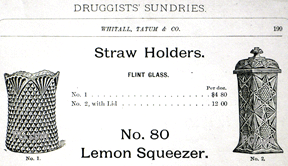 |
| Above are some very interesting advertisements from the Whitall, Tatum & Co., a pharmacy supply catalog. Above left are shown the "SPOON" (spooner) and "STRAW HOLDERS" (actually a celery vase) and above right are shown "Straw Holders" - actually a celery vase & a covered straw jar. These ads are reprinted here courtesy of the American Institute of the History of Pharmacy, Kremer's Reference Files, Madison, Wisconsin. The reason they are so interesting is that the catalog has snatched a Fostoria Czarina pattern celery vase (shown with the same pattern's spooner) and shazam - renamed it a straw jar! How's this for creative merchandising? |
|
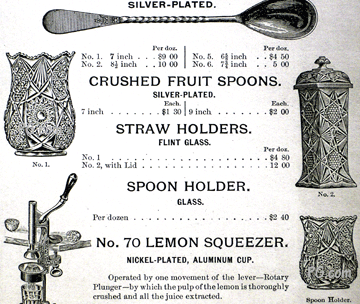 |
And the advertised illustration on the left, from Whitall, Tatum & Co. in a 1899 pharmacy supply catalog shows a straw jar version that appears as a vase & was never intended to have a lid. This is the Fostoria 1897 pattern, Brazilian, with the celery vase (see below) also called a straw jar! This ad is reprinted with the courtesy of the American Institute of the History of Pharmacy, Kremer's Reference Files, Madison, Wisconsin. |
| Here is a genuine Fostoria Brazilian piece featured in the above ad. Its a good bet that few, if any, Early American Pattern Glass folks realized that what has been called a celery vase for lo these many years, was ever commercially contemplated to be a holder for straws! So could this be one of the mystery uses of celery vases we've been wondering about? | 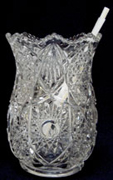 |
| A study of straw jar evolution has uncovered intriguing issues involving the life cycle of a manufacturing process as well as the public's appetite for the latest style. Through research of both manufacturer catalogs and trade catalogs it has been found that a manufacturer's production of an object stops well before their inventory is ultimately sold off and distributed. In the same regard, a wholesaler (i.e. trade catalog distributor) will continue to advertise a product until their inventory is depleted or the object is considered obsolete and is simply discounted or scrapped. And so EAPG straw jars are shown in trade publications spanning into the 'teens because they were listed as available for purchase in trade catalogs dating to that time. There is no solid data as to when examples of EAPG containers for straws were no longer being produced. |
| Most of us have pleasant memories of our early soda fountain experiences. But long before we had our first sip of soda, the EAPG straw jar existed, serving an earlier generation who enjoyed soda fountain treats every bit as much as we did. These beautiful & functional jars remain as soda fountain fixtures from some of the happier times of America’s past! |
Our grateful thanks to a dear friend of PatternGlass.com for the generous historical & pictorial contributions to this article. |
 |
 |
 |